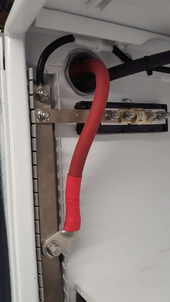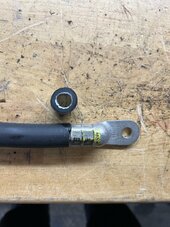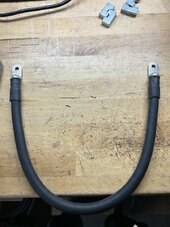This thread and overall inquiry is about the reality of 4/0 welding cable's amp ratings of the different classes on the market.
This is in relation to high capacity LFP cabinets, bus bars, Victron 10kva Quattros and energy transfer.
Does anyone know why..... AND/or if it's true.. that...
"Ultra-Flex" cable for welding (orange with black stripe) has more ampacity than...
"M-class" (all orange)...
or...
"K-class" (typical/normal welding cable)????
Ie
4/0 (for let's say)...
50 ft & 600vdc:
• Ultra-Flex... 600amps
• M-class.... 405amps
• K-class... 310amps
That's what the literature has on amps for each class product in the few places i looked.
I know that wire strand count goes up in each class. And i think the insulator also gets a tweak.
But does it really increase amperage abilities (again 50ft max run and all things equal)?
I think...
4/0 Ultra-Flex may have the highest strands (based on 2/0)... X,xxx of 34awg
(... no ref for 4/0,,, but 2/0 is 3,087 at 34 awg)
4/0 M has next highest (i aSSume).... 5,225 strands of 34awg
4/0 K has the least of the three... 2,054 of 30awg
Is this all just marketing hype/gimmicks?
Thanks in advance!



------
update 3/3/24
Also was just told by one distributor of the USA made M-class that the amperage rating is only an "intermittent" rating.
They contacted the manufacturer.
They did not (would not) associate a time at that amperage.
I assume ALL welding cable works that way... Only the max intermittent rating published.
This is in relation to high capacity LFP cabinets, bus bars, Victron 10kva Quattros and energy transfer.
Does anyone know why..... AND/or if it's true.. that...
"Ultra-Flex" cable for welding (orange with black stripe) has more ampacity than...
"M-class" (all orange)...
or...
"K-class" (typical/normal welding cable)????
Ie
4/0 (for let's say)...
50 ft & 600vdc:
• Ultra-Flex... 600amps
• M-class.... 405amps
• K-class... 310amps
That's what the literature has on amps for each class product in the few places i looked.
I know that wire strand count goes up in each class. And i think the insulator also gets a tweak.
But does it really increase amperage abilities (again 50ft max run and all things equal)?
I think...
4/0 Ultra-Flex may have the highest strands (based on 2/0)... X,xxx of 34awg
(... no ref for 4/0,,, but 2/0 is 3,087 at 34 awg)
4/0 M has next highest (i aSSume).... 5,225 strands of 34awg
4/0 K has the least of the three... 2,054 of 30awg
Is this all just marketing hype/gimmicks?
Thanks in advance!
------
update 3/3/24
Also was just told by one distributor of the USA made M-class that the amperage rating is only an "intermittent" rating.
They contacted the manufacturer.
They did not (would not) associate a time at that amperage.
I assume ALL welding cable works that way... Only the max intermittent rating published.
Last edited:






